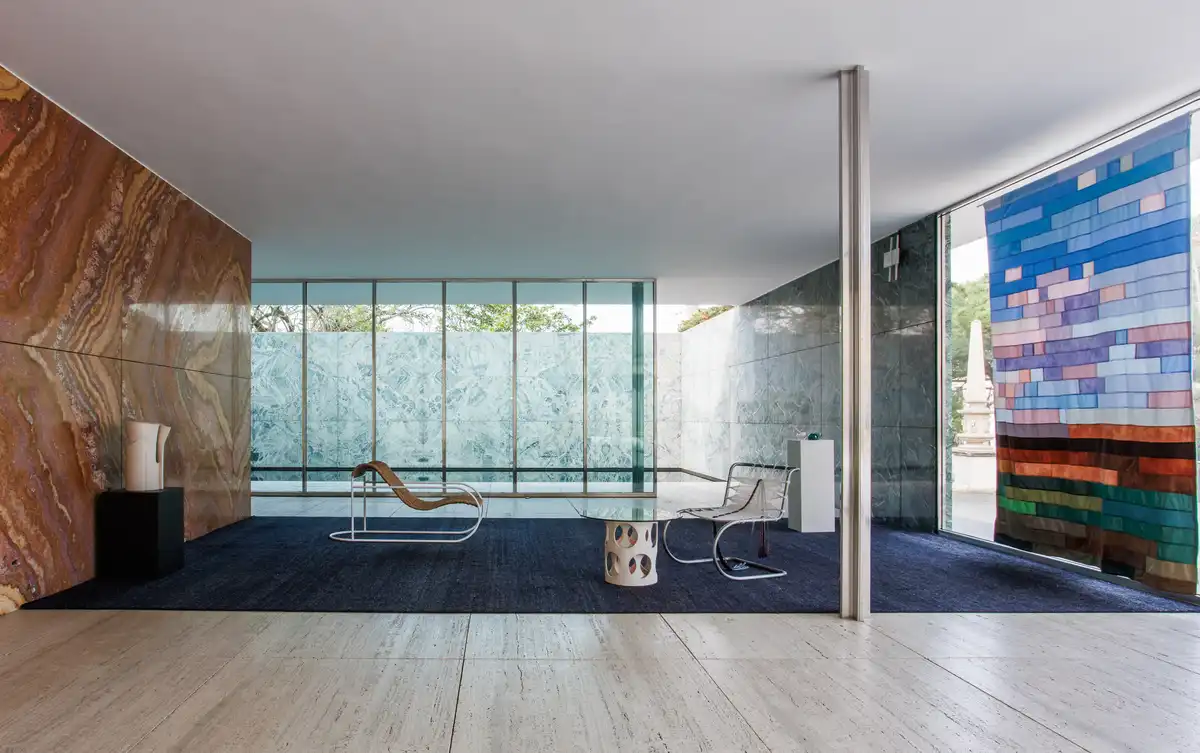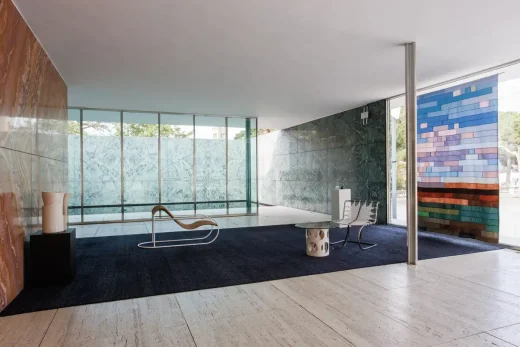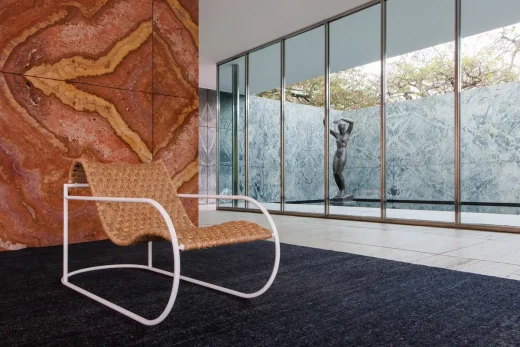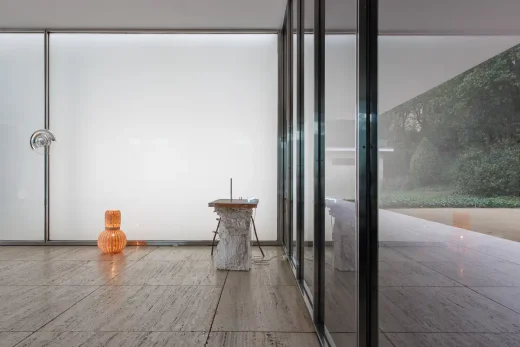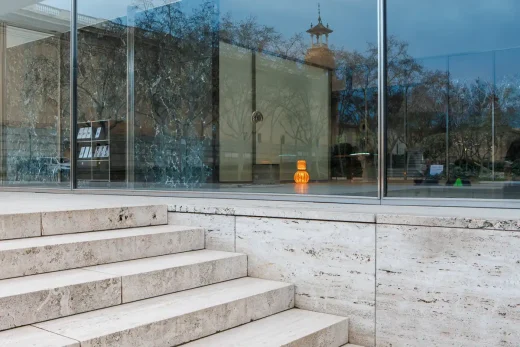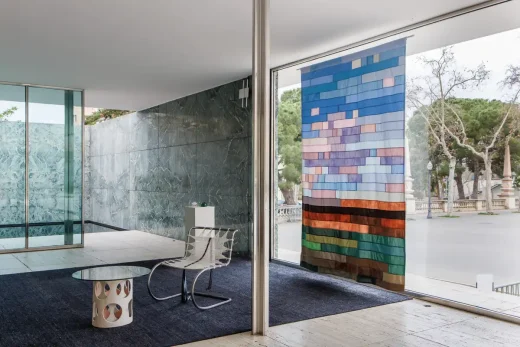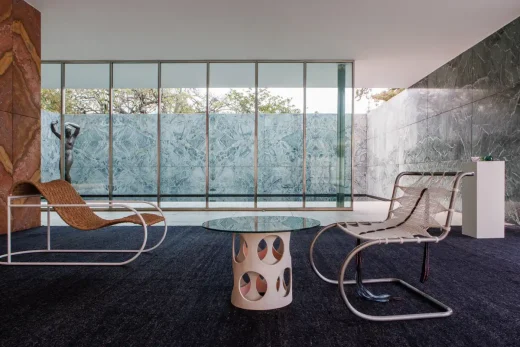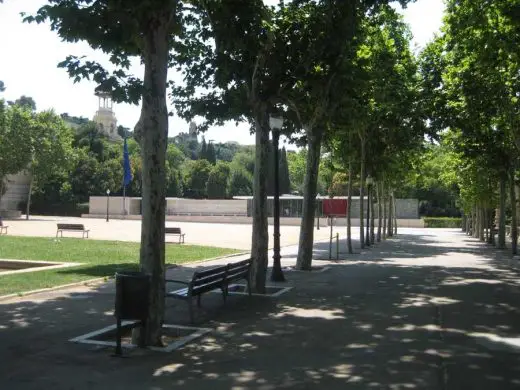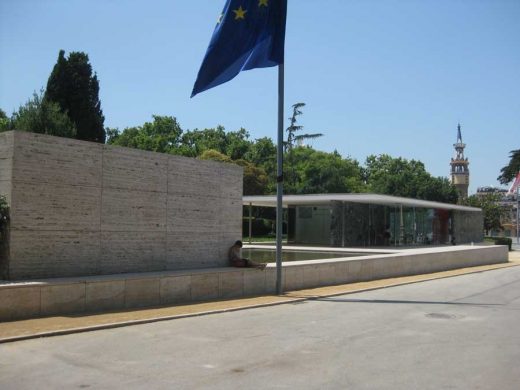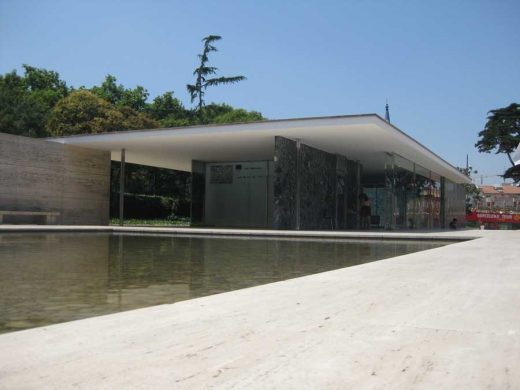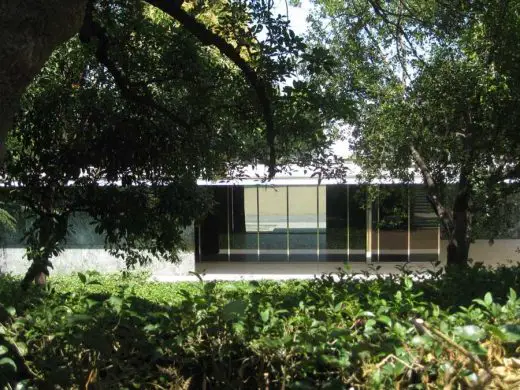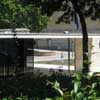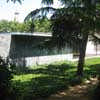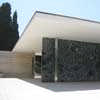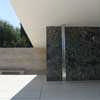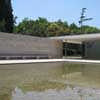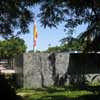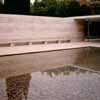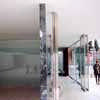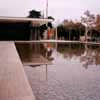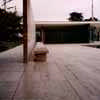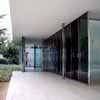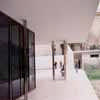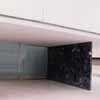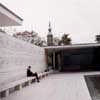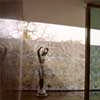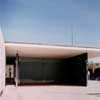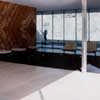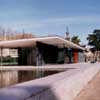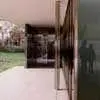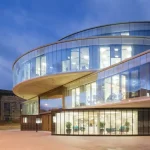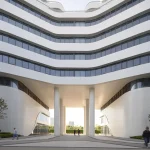Barcelona Pavilion photos, 20C Catalan architecture pictures, Spanish Mies van der Rohe building
Barcelona Pavilion Photos
Photography of German Pavilion in Spain – Mies van der Rohe Modern Catalan architecture images.
post updated 10 May 2025
Address: Av. de Francesc Ferrer i Guàrdia, 7, Sants-Montjuïc, 08038 Barcelona, Spain
Architects: Ludwig Mies van der Rohe, Lilly Reich
Architectural style: Modern architecture
Phone: +34 932 15 10 11
Coordinates: 41°22′14″N 2°09′00″E / 41.37056°N 2.15000°E
Construction started: 1928
Opened: 1929
Demolished: 1930 (rebuilt replica in 1986)
‘Una cambra pròpia’
an intervention at the Mies van der Rohe Pavilion that reclaims the role of women in the history of design
Una cambra pròpia_Fundació Mies Van der Rohe with Galeria Illacions:
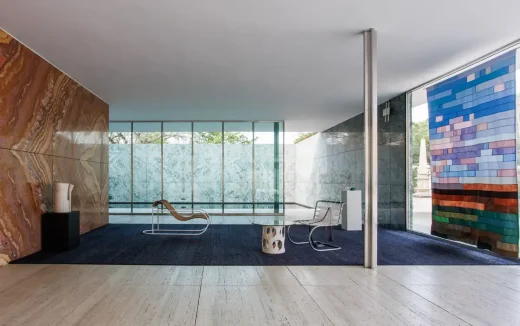
Photos: Anna Mas
“Una cambra pròpia” → Reclaiming the role of women in design at the Mies van der Rohe Pavilion
From February 28, 2025, to March 9, 2025, at the Mies van der Rohe Pavilion, aka Barcelona Pavilion, Spain.
3 March 2025
Mies van der Rohe Pavilion Architecture Intervention
On the eve of International Women’s Day the Fundació Mies van der Rohe in collaboration with Galeria Il·lacions presents “Una cambra pròpia“, an artistic intervention at the Mies van der Rohe Pavilion. A tribute to all the women who have made pioneering contributions to the field of furniture and object design, bringing their ingenuity and intelligence to the sector through their dedication.
The title “Una cambra pròpia” (A Room of One’s Own’, in catalan) alludes to Virginia Woolf’s essay, transferring its message—centered on the analysis of historical and social limitations—into the field of applied arts, with the aim of making women’s role in product design more visible and paying tribute to it. In this intervention, ten contemporary designers have taken on the challenge of creating new furniture and objects, each inspired by a reference figure in the world of design and architecture.
The authors of the intervention—Carla Cascales, Ines Sistiaga, Jana Tothill, Sanna Völker, Marria Pratts, Laura Molina, Mago Hart, Si.atelier, Mariadela Araujo, and Rosa Cortiella—draw inspiration from and pay homage to Eileen Gray, Lilly Reich, Anni Albers, Aino Aalto, Charlotte Perriand, Eva Zeisel, Lina Bo Bardi, Franca Helg, Andrée Putman, and Maria Pergay, all pioneers in the world of design. Together, they recreate this room that Virginia Woolf considered one of the two essential things a woman needs to fully develop her creative potential: money and a space of her own.
“Una cambra pròpia”
From 28.03.25 to 09.03.25
28.02.2025 at 1:00 p.m.- Presentation and debate with the authors + Presentation of the research Transnational narratives/Lilly Reich Grant
In cases such as Lilly Reich, Charlotte Perriand, or Franca Helg, their authorship was overshadowed by architects like Ludwig Mies Van der Rohe, Le Corbusier, and Franco Albini. Others, like Aino Aalto—one of the first European women architects and a winner of multiple design awards—collaborated with Alvar Aalto on significant architectural projects that, at first, were solely attributed to him.
Eileen Gray was a pioneer in perfecting the lacquer technique in furniture and was already using tubular metal in the 1920s, while Anni Albers made enormous contributions to the textile industry with her “pictorial weavings.” Eva Zeisel was the first woman to exhibit at MoMA with her ceramic works. Architect Lina Bo Bardi left a significant legacy advocating for humanistic, ecological, and accessible constructions. Maria Pergay was a pioneer in creating stainless steel objects and furniture in the 1970s, when few women had a presence in the sector.
The original pieces presented in this intervention are contemporary interpretations of this legacy:
Carla Cascales draws inspiration from Eileen Gray with Villa, a chaise longue that synthesizes the materials and architectural lines of Villa E-1027. The white armchair recalls the original hue of the house before Le Corbusier painted his murals without Eileen’s permission. Cascales designs a lounge chair that functions as a recliner—meant for resting by the sea, reading in the sun, or simply relaxing.
Inés Sistiaga takes inspiration from Lilly Reich with Version of the MR 10 Weissenhof Chair, a reinterpretation of the chair designed by Reich and Mies van der Rohe in 1927. Sistiaga transforms the piece into a double seat, triangulating authorship within the creative duo. Additionally, “she weaves” Reich’s biography into the piece. Through this intervention, the designer aims to “shed light beneath Mies’ shadow to illuminate Reich’s lasting influence on the world of design and architecture,” as she expresses.
Jana Tothill is inspired by Anni Albers with A View of Our Own, a curtain paying tribute to Albers’ pictorial textiles. The piece, based on a pixelated photograph of the view from her window, celebrates the concept of home and place. It was created as an intergenerational project alongside her mother and grandmother.
Sanna Völker takes inspiration from Aino Aalto with Näkki, a series of mirrors evoking water waves and Aalto’s glassworks. In this piece, Völker also draws from the myth of Näkki, a mystical water spirit lurking in lakes, ponds, and murky waters beneath bridges—captivating those who gaze in search of their own reflection.
Marria Pratts channels Charlotte Perriand with Entre els Vestigis del Procés de la Pintura, a table composed of personal objects and diverse materials. Pratts interprets painting as an unexpected landscape, as she describes: “Around the canvas, an unexpectedly marvelous landscape flourishes. This landscape is where I love to walk and spend my day. This table is the result of that fortuitous landscape.”
Laura Molina draws from Eva Zeisel with E-Z VASE, a glazed ceramic vase reinterpreting Zeisel’s formal universe, with particular attention to the organic and curved shapes that define her work.
Mago Hart is inspired by Lina Bo Bardi with Float, a series of modular glass cups that, beyond their function, have a sculptural quality. These glasses explore the relationship between ice and time, incorporating a tray to contain the melted ice, transforming the drink as time passes—an allusion to Lina Bo Bardi’s concept of unfinished design.
Si.atelier takes inspiration from Franca Helg with La Helg, a wicker lamp paying tribute to the designer’s legacy, particularly her work with this material. La Helg blends functionality and craftsmanship, creating a cozy atmosphere with both practical and emotional lighting. Its flexible design allows it to adapt to different times of the day, offering five lighting modes in a single lamp thanks to its detachable and mobile structure.
Mariadela Araujo draws inspiration from Andrée Putman with Courage, a piece based on the rug design Putman created for the Morgans Hotel. Araujo explores Putman’s drive to craft accessible and beautifully imperfect pieces. For this work, she employs an unconventional process, incorporating an unexpected volume that highlights the uniqueness of the piece.
Rosa Cortiella takes inspiration from Maria Pergay with Tribut I, a side table. Pergay’s Rare Dining Table inspired Cortiella to create this new piece. In her reinterpretation, the artist designs two robust, perforated ceramic cylinders that mimic the appearance of stainless steel—a material pioneered by Pergay—to support the table’s glass top.
The opening event will take place on February 28, 2025, at 1:00 PM at the Mies van der Rohe Pavilion, with the presence of the artists and designers.
The installation will be on display, included in the admission price to the Mies van der Rohe Pavilion, until March 9: the journalist Ariadna Rousaud will moderate a conversation with representatives from Il·lacions Gallery and the ten authors of the pieces from Una cambra pròpia.
As a preludi tothe inauguration, the project “Transnational Narratives: A documentary that celebrates South Asian women in architecture” by Igea Troiani, Mamuna Iqbal and Paula Roush will be presented with the support of the fourth Lilly Reich Scholarship for equality in architecture, with a brief conversation between Anna Ramos, director of the Mies van der Rohe Foundation, and Laida Memba, jury member.
Very soon, on Monday, March 3 at 12:30 in the Assembly Hall of ETSAB, the winners of the third Lilly Reich Scholarship for equality in architecture will share with Anna Bofill Levi the inaugural lesson of the course.
+++
About the Fundació Mies van der Rohe
In addition to conserving and disseminating knowledge of the Mies van der Rohe Pavilion, the Fundació promotes knowledge, research, debate, and awareness on topics related to modern and contemporary architecture and urbanism.
The Mies van der Rohe Fundació was established in 1983 by the Barcelona City Council with the initial goal of reconstructing the German Pavilion that Ludwig Mies van der Rohe and Lilly Reich designed for the 1929 Barcelona International Exposition.
About the Artistic Interventions Program at the Mies van der Rohe Pavilion
The interventions that take place at the Mies van der Rohe Pavilion are a unique activity in the city based on the exceptional spaces within the Pavilion. They maintain active interpretations and give meaning to the Pavilion’s relevance today through proposals by experts from various cultural fields.
About the Mies van der Rohe Pavilion
The German Pavilion in Barcelona was designed by Ludwig Mies van der Rohe and Lilly Reich as Germany’s pavilion for the 1929 Barcelona International Exposition held at Montjuïc. This symbolic work of the Modern Movement has been extensively studied and interpreted, inspiring the work of several generations of architects.
Built with glass, steel, and various types of marble, the Pavilion was conceived to host the official reception presided over by King Alfonso XIII along with German authorities. After the Exposition closed, the Pavilion was dismantled in 1930. Over time, it became a key reference in both Mies van der Rohe’s career and 20th-century architecture. The significance and recognition of the Pavilion led to the idea of reconstructing it.
In 1980, Oriol Bohigas initiated this project from the Urban Planning Department of the Barcelona City Council, and architects Ignasi de Solà-Morales, Cristian Cirici, and Fernando Ramos were appointed to research, design, and oversee the reconstruction of the Pavilion. The works began in 1983, and the new building was inaugurated on June 2, 1986, at its original location.
About Galeria Il·lacions
Galeria Il·lacions (2011) is the first gallery exclusively dedicated to 21st-century collectible design linked to Barcelona. Its purpose is to create value and provide visibility for the more than 70 creators it collaborates with, showcasing their furniture and objects, unique pieces, or limited series in temporary exhibitions, international fairs, and its permanent collection.
Il·lacions also develops projects related to design and creativity, contributing its collective intelligence to private sector projects and spin-off projects of the gallery. Other areas of activity include exhibition curating, singular interior design projects, collection consulting, furniture and object production, R&D, book publishing, and design residencies.
About Carla Cascales
Carla Cascales, based in Barcelona, blends minimalism with architectural influences such as brutalism and a strong Mediterranean essence. Her work is inspired by the Japanese aesthetic of “Wabi Sabi,” emphasizing the beauty of irregularity and impermanence. Cascales constantly explores the essence of forms and balances natural materials, placing high value on authenticity. She finds deep inspiration in fluidity, calm, depth, light reflections, and the vastness of the Mediterranean.
Carla Cascales has held solo exhibitions in cities like Barcelona, Madrid, London, and Los Angeles, and has created artistic installations at institutions like Matadero Madrid and La Caixa in Barcelona. Her work is part of collections at institutions such as MACBA and the Masaveu Peterson Foundation. She was named Best Emerging Artist at the Swab Art Fair in Barcelona.
About Inés Sistiaga
Inés Sistiaga is a textile designer and researcher based in Madrid. After studying Jewelry at the Escola Massana in Barcelona, she moved to the Netherlands to pursue a degree in design at the Design Academy Eindhoven. A university professor and independent designer, she evolves as a textile researcher and knitwear programmer, offering advice on creative projects.
Her work, primarily focused on the exploration of materials and textile structures, develops studies ranging from function to aesthetics and technique to decoration. Through trial and error processes, Inés explores visual languages and material constructions using both handcrafted and digital technology. For Sistiaga, textiles are a tool, and her research materializes in proposals within the fields of design and interior design.
About Jana Tothill
Jana Tothill is a designer and researcher with a strong focus on sustainable practices and innovative design methodologies. She holds a degree in Space Design from the University of the Arts London and a Master’s in Design for Emerging Futures from the Institute of Architecture of Catalonia. She is dedicated to creating transformative experiences within design. Her extensive professional training includes roles in design research, curating, and education, highlighting her adaptability and commitment to driving positive change in the industry.
Her work focuses on research and exploration of materials, engaging in sustainable and innovative solutions, urbanism, and the development of intergenerational living spaces. She also experiments with new design methods and theories such as posthumanism and feminist materialism. A key part of her work involves collaborating with other designers and artists to create installations and experiences that provoke reflection.
About Sanna Völker
Sanna Völker is a Swedish designer who works between Scandinavia and Spain. Her work can be described as a search for balance between rawness and refinement, harmony and intrigue. Her designs often feature architectural references, manifested in furniture and objects with pure forms. Working with natural materials, her pieces consist of clear geometries with timeless expression.
About Marria Pratts
Marria Pratts is an artist who radiates an uninhibited and spontaneous aura through her creations. Inspired by her immediate surroundings in Hospitalet, her work can be interpreted as a challenge to societal structures, the contradictions permeating urban landscapes, and the challenges of living under the constant threat of gentrification. With her instinct for artistic creation, Pratts conveys an encouraging sense of resilience. Throughout her dynamic career, she has exhibited in ‘Panorama 21’ at the MACBA (Barcelona), ‘Lil Ghost Say Hello’ in Antwerp (2021), and had 3 solo shows last year: ‘I love U Freestyle’ in Cologne, ‘1 Possession Drift’ in Barcelona, and ‘Melted with U’ in New York. This year, she exhibited ‘1 Sarda 3 Fantasmes’ at the Liceu in Barcelona, ‘Welcome To My Garden’ in Antwerp, and ‘Big Landscape’ in Tokyo.
About Laura Molina
Laura Molina, born in 1974 in Alicante, Spain, began her career in sculpture and graphic art. Later, she transitioned into roles in public institutions and private companies related to art, creation, and cultural heritage. Notably, she was the director of artistic interventions at General de Producciones y Diseño S.A. for four years. In 2011, her passion for objects led her to co-found Todomuta Studio with designer and photographer Sergio Herrera, where she serves as creative director. She is also the art director at Icaria Atelier.
About Mago Hart
Magdalena Hart (Mago) is a digital artist and interactive installation designer from the UK/Uruguay. Co-founder of the Akyute collective (2019), which focuses on integrating nature into the digital age. In her practice, she uses technology as a tool to reconnect humanity with its environment and natural systems, merging experience design, generative sound, and audiovisual arts.
About si.atelier
si.atelier is composed of Sonia and Isabel, product designers, spatial creators, and innovators. United by the same concerns and intentions, their challenge is to achieve the perfect fusion between each space and its content. si.atelier aims to provoke new sensations to generate unique experiences through textures, light, and the exposure time.
About Mariadela Araujo
Mariadela Araujo is a Venezuelan/Spanish artist, designer, and educator based in Barcelona. She runs a studio where she explores traditional textile techniques such as weaving and embroidery, creating art, functional objects, and installations with vibrant colors. Mariadela has been recognized by AD Magazine Spain as one of the best Spanish designers. She has created various works, from large installations for public spaces to smaller experimental pieces. Her clients include Loewe, Saatchi Art, EÈRA, WeWork, and others. Her work has been exhibited in cities like Brussels, Paris, Barcelona, Rotterdam, Amsterdam, Mallorca, Caracas, and Erevan.
About Rosa Cortiella
Rosa Cortiella has always shown a deep interest in promoting the endless creative possibilities of ceramics. Her work has been professionally recognized in national and international exhibitions and competitions. She holds a degree in Fine Arts from the University of Barcelona, specializing in painting, and a degree in ceramics and sculpture.
She has been professionally dedicated to ceramics since 1988 and is interested in formal and artistic experimentation within the ceramic medium. Her multidisciplinary training allows her to work across sculpture, product design, and color research. For many years, her work has focused on the design and production of limited editions, primarily in the high-end culinary sector. She combines her professional career with teaching and ceramic workshops
@fundaciomies #UnaCambraPròpia #barcelonapavilion #miesbcn
More infomration online soon
post updated 27 Mar 2021
Barcelona Pavilion Photographs
Barcelona Pavilion – photos from Summer 2011 © architect Adrian Welch
Location: Montjuïc – scenic wooded hill in the Southwest of the city, close to the centre
This Modern building design by architect Mies van der Rohe is famous across the globe. It is celebrated for its innovative architectural design, creating a floating roof over beautifully designed chrome-plated cruciform columns.
The reflecting pool filled with pebbles, and the small pool with sculpture on the North side, add contemplative delight that works in harmony with the International Style building.
Adrian Welch, e-architect founding Editor.
Barcelona Pavilion architecture photos from December 2005 © architect Adrian Welch – selection below:
More Barcelona Pavilion images available upon request: all photos 1280×1024 pixels, 72dpi
Further information regarding visiting hours, entry, etc.
English text:
Mies van der Rohe Pavilion
Spanish text:
Pabellón Mies van der Rohe
Mies van der Rohe building
Barcelona Pavilion photos – scanned photographs from 1989 © Isabelle Lomholt
Barcelona Pavilion architect : Mies van der Rohe
More photos of this beautiful 20th Century Catalan building:
17 June 2020
The Lilly Reich Grant for Equality in Architecture.
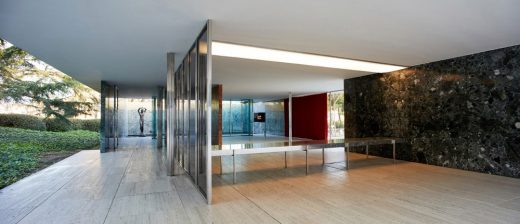
photograph : Pepo Segura, courtesy FMvdR
The Lilly Reich Grant for Equality in Architecture
Marking the 135th anniversary of the birth of the german designer, Fundació Mies van der Rohe presents the 2nd edition of The Lilly Reich Grant for Equality in Architecture.
Location: Montjuïc, Barcelona, Catalonia, Northeast Spain
Comments on this major 20th Century building located in Catalunya, Northeast Spain article are welcome.
+++
Architecture in Barcelona
Barcelona Architecture Walking Tours – Catalan capital city walks by e-architect
Some recent Catalan architecture designs on e-architect:
ACCIONA Energía Pavilion building, Moll de la Fusta
Architects: Institute for Advanced Architecture of Catalonia (IAAC)
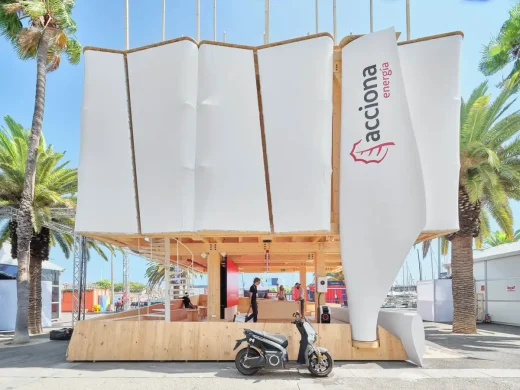
photo : Adrià Goula
Modulus Matrix Social Housing, Cornellà
Architects: Peris + Toral Arquitectes
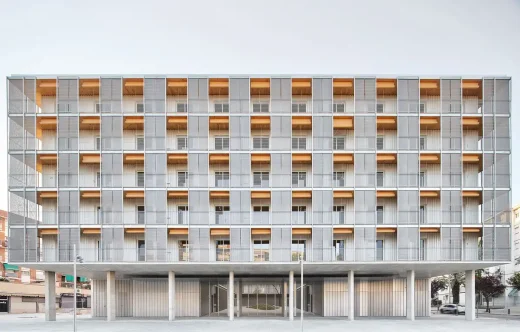
photo © José Hevia
Casa Batllo – Quayola façade mapping of this famous Gaudi building
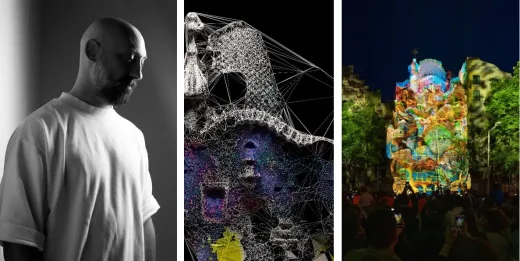
image : Claudia Maurino
+++
Famous Modern Houses
Famous Modern Houses – building selection:
Maison Louis Carré, Bazoches-sur-Guyonne, France
Design: Alvar Aalto, architect
Modern French House
Martin House Complex, Buffalo, USA
Design: Frank Lloyd Wright
Modern Architecture in Buffalo
Philip Johnson Glass House, New Canaan, Connecticut, USA
Farnsworth House, Plano, Illinois, USA
+++
Tugendhat Villa Brno building design by architect Mies van der Rohe
Another building by Mies van der Rohe : National Gallery Berlin
Another key building by Mies van der Rohe : Seagram Building, New York
More Catalan building designs:
Barceloneta Market
Architect: Josep Miàs
Aura’s Insurance Company Building in Barcelona
Design: Pich Architects
Ocular Microsurgery Institute
Josep Llinàs Carmona architect
Comments / photos for the Barcelona Pavilion Photographs page welcome

